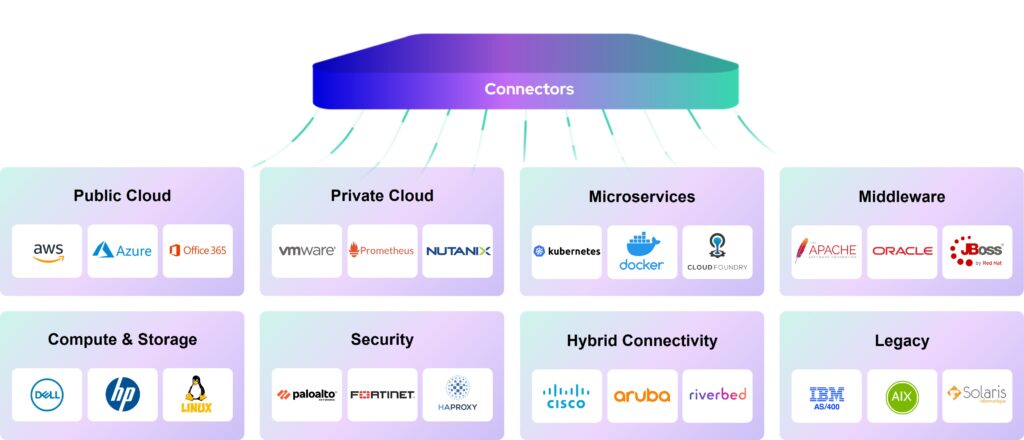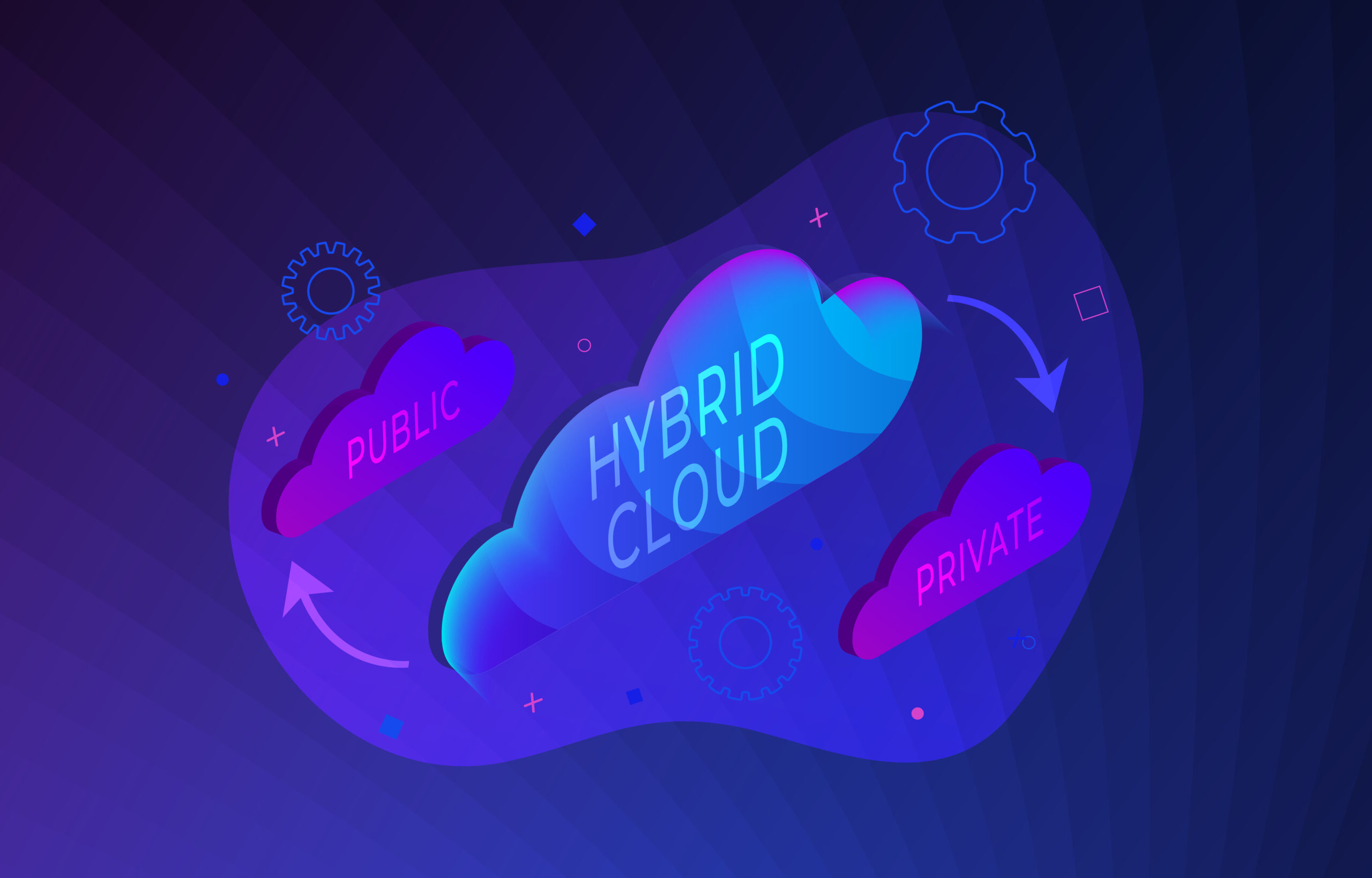Hybrid IT combines various cloud services, private or public, with other types of on-premises or edge IT infrastructure. This computing strategy is changing how ITOps think about IT infrastructure monitoring. The focus is on a unified view of workflows and IT performance—which entails consolidating IT infrastructure monitoring within a single platform for cloud to edge visibility. This blog post frames the issue of hybrid IT and the monitoring challenges that are specific to hybrid IT—helping you find the perfect hybrid IT monitoring solution and obtain the benefits of seamlessly monitoring hybrid environments.
A hybrid IT monitoring solution that’s as flexible as your digital needs
Cloud is an essential part of your organization’s digital journey. Software as a Service (SaaS), Infrastructure as a Service (IaaS), or a little of both with Platform as a Service (PaaS) options provide optimal and affordable digital capabilities. But your organization is still integrating these platforms with on-premises or edge technologies for security and data ownership considerations, for example, or the need to keep data closer to users to improve speed. You’re more than likely already managing hybrid IT—although you may not yet benefit from the advantages and security of a hybrid IT monitoring solution.
What is hybrid IT?
Hybrid IT refers to a computing strategy which organizations employ to achieve technological agility. It entails combining on premises and cloud-based IT services which are provided and managed centrally. This approach provides the best of both worlds: the control and stability of on-premises assets with the flexibility and affordability of cloud computing. Hybrid IT is not to be confused with hybrid cloud, which entails combining private and public cloud services.
What is hybrid cloud?
Hybrid cloud refers to a cloud architecture in which an enterprise combines public and private clouds for seamless workload migrations between the two infrastructure elements. This can be done either in duplicate, for added operational resiliency, or by dividing workloads between private or public clouds, so they can work together, for more flexibility in managing computing needs. In short, as in combining on premises and cloud, mixing private and public cloud offers the hybrid benefit of control and flexibility.
An overview of common hybrid infrastructure options
Software as a Service (SaaS)
SaaS offerings are usually provided through a subscription model to be augmented as needed. A good example of such a platform is Microsoft Office 365, but there are countless others in a wide range of business areas, including infrastructure monitoring. Did you know Centreon is now available as a SaaS offer?
Infrastructure as a Service (IaaS)
IaaS provides on demand compute, storage, and networking resources based on a per-use fee. Amazon Web Service or Microsoft Azure are popular examples of such platforms which help organizations limit their involvement in managing infrastructure while benefiting from all the flexibility needed on how and for which workloads the infrastructure is used.
Platform as a Service (PaaS)
PaaS combines both SaaS and IaaS elements to provide both software and infrastructure. PaaS is often used to maximize efficiency in launching applications. Such services are either offered through a pay-as-you-go or a subscription model. Google App engine is an example of such a platform.
The benefits of hybrid IT
Control and security
Hybrid IT environments, as we saw above, offer the security and control on-premises environments afford, while providing the cloud’s cutting-edge flexibility and scalability. Organizations can split their data across the most suitable environment, meeting regulatory or standard-related requirements, while benefiting, for less sensitive data, of the best options the cloud has to offer to deploy apps and move workflows seamlessly.
Cost and operational efficiency
The advantage of hybrid infrastructure is that you can pay for more computing or storage on a per need basis, and you can skip a lot of the resources—human or material, needed to acquire, launch, and manage such assets, as typically this is supported by the cloud infrastructure vendor.
Agility and future readiness
Mixing on premises with hybrid cloud, you never have to worry about ill-fitting capabilities. You can scale back or scale up at will to match current hosting or computing needs. This makes an organization’s environment extremely malleable and always ready for new deployments, within a framework of constant optimization.
Hybrid IT and the need for a hybrid IT monitoring solution
Although hybrid IT and hybrid cloud are two different things, they bring similar advantages. They both come with infrastructure monitoring challenges, because very few IT monitoring solutions on the market can provide comprehensive visibility on an ever-changing, complex environment, as well as display IT service interdependencies.
The perils of limited hybrid IT monitoring capabilities
A typical roadblock in monitoring hybrid IT is the multiplication of monitoring tools (14 on average, according to the State of IT Monitoring), which slows the process of diagnosing issues, resulting in unsatisfactory MTTR with all of the broader consequences of imperfect IT service on the digital business.
Then, there are the inherent risks of leaving entire IT areas in the dark because some assets remain out of monitoring reach. Whether the action happens through infrastructure under their direct control or through infrastructure managed by a third party, end-to-end visibility on workflows from a single monitoring console is an inescapable feature of delivering flawless digital experiences.
Monitoring dark spots also limit the ability to use monitoring data for more advanced purposes, such as automation, guiding computing procurement decisions, demonstrating SLAs, or gaining business insights through feeding such data to an observability solution.
Advantages of a hybrid IT monitoring solution
- Removes IT monitoring silos by providing monitoring capabilities for all physical, virtual, and cloud-based infrastructure within a single, customizable, and shareable monitoring console.
- Equips IT teams with the visibility and information they need to proactively identify and resolve issues well before users notice service degradation or downtime.
- Enables the collection and correlation of performance and availability data from virtually any device, facilitating IT service management, capacity planning, and IT service optimizations.
- Allows to focus IT monitoring on business workflows rather than on the underlying equipment, for a clear understanding of resources interdependencies, deepening the value of IT monitoring and opening a new culture of collaboration with other key digital business stakeholders, such as DevOps.
how are hybrid IT environments monitored?
ITOps are turning to API-based hybrid IT monitoring solutions to extend their monitoring capabilities to on-premises infrastructure, cloud infrastructure in all their variations, as well as elements at the edge, as IoT gains ground in modern IT environments.
Through a connector approach, Centreon allows to monitor virtually any device in any environment, including the cloud, whether it is Amazon AWS or Microsoft Azure monitoring for public IaaS and PaaS cloud services, Kubernetes and Docker monitoring for private cloud infrastructure, or Office365 and other typical SaaS offerings.

In fact, with Centreon, it’s not what you monitor that matters, it’s the KPIs you collect and combine to inform on the performance of crucial business workflows—in the cloud or elsewhere, transforming monitoring data into easily shareable insights that help manage digital performance holistically.
Try Centreon today—and get complete visibility from cloud to edge.
To go further:
- Centreon is available in multiple editions and you can also choose how to deploy it regarding your business strategy. The choice is yours: SaaS with Centreon Cloud or Self-Hosted with Centreon On-Premise.
- To select the best deployment option for your IT monitoring solution, let us guide you through the TCO Approach. Our latest expert content examines the deployment model impact (SaaS or self-hosted) on a monitoring solution’s TCO, so you can choose the one that will meet both your technological expectations and your budget.
- There is one last frontier for IT modernization: the very tools used to monitor the organization’s operational performance, IT monitoring. Learn How with this ebook Modernizing IT Monitoring for Cost Effectiveness and Performance – How to Modernize Across—And Deep Into the ITOps Stack.
You’d rather chat directly with our experts? Contact us.















